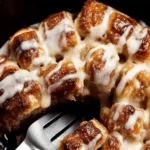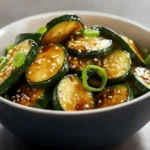The Ham and Cheese Quiche is a classic crowd-pleaser that brings elegance and ease together in one savory, golden slice. Featuring a flaky pie crust filled with a luscious egg custard, generous bits of savory ham, sharp cheddar, and gooey mozzarella, this dish is a comforting embrace of flavors and textures.
Perfect for breakfast, brunch, or a light dinner, this quiche is also fantastic served chilled or at room temperature, making it ideal for entertaining or meal prep. Whether you’re hosting a brunch or preparing weekday lunches in advance, this easy-to-make quiche offers warmth, flavor, and versatility in every bite.
Full Recipe:
Ingredients:
-
1 unbaked 9-inch pie crust (homemade or store-bought)
-
6 large eggs
-
1 cup whole milk
-
1/2 cup heavy cream
-
1 cup cooked ham, diced
-
1 cup shredded cheddar cheese
-
1/2 cup shredded mozzarella cheese
-
1/4 cup finely chopped green onions
-
1/2 teaspoon salt
-
1/4 teaspoon ground black pepper
-
1/4 teaspoon garlic powder
-
1/4 teaspoon onion powder
Directions:
-
Preheat the oven to 375°F (190°C).
-
Carefully place the pie crust into a 9-inch pie dish. Trim and crimp the edges as desired. Place in the fridge while you prepare the filling.
-
In a large mixing bowl, whisk together the eggs, milk, and heavy cream until smooth.
-
Stir in the ham, cheddar cheese, mozzarella cheese, green onions, salt, black pepper, garlic powder, and onion powder.
-
Pour the filling mixture into the prepared pie crust, spreading it out evenly.
-
Place the quiche on a baking sheet and bake for 40–45 minutes, or until the center is set and the top is golden brown.
-
Let the quiche cool for at least 10 minutes before slicing. Serve warm or at room temperature.
Prep Time: 10 minutes | Cooking Time: 45 minutes | Total Time: 55 minutes
Kcal: 330 kcal | Servings: 8 slices
A Classic with Timeless Appeal
Few dishes straddle the line between comfort food and sophisticated fare as effortlessly as a ham and cheese quiche. Its golden, buttery crust and velvety egg custard evoke memories of leisurely weekend brunches, yet the quiche retains an air of elegance suitable for bridal showers, business luncheons, or a candlelit dinner for two. Part of its magic lies in versatility: you can slice it warm and melty straight from the oven or serve it chilled the next day, discovering how the flavors mellow and deepen overnight. That adaptability, coupled with minimal hands-on time, has secured quiche a permanent place in home kitchens and professional bakeries alike.
Tracing the Roots: From French Cuisine to Global Favorite
The culinary lineage of quiche reaches back to the medieval kingdom of Lothringen an area that bounced between French and German rule and is now known as Lorraine. Early versions were simple just cream, eggs, and bacon baked in bread-dough walls. Over centuries, butter-enriched shortcrust replaced bread, bacon broadened to include cured meats like ham, and cheese jumped into the mix, giving birth to the quiche formats we recognize today. As French émigrés settled abroad and haute cuisine caught the world’s imagination during the 20th century, quiche spread rapidly. American cafés adopted it in the 1950s, Australian brunch spots by the ’70s, and now even convenience stores in Tokyo stock personal-sized wedges. The ham-and-cheese combination remains the gateway flavor for many first-time quiche eaters because it feels familiar reminiscent of childhood sandwiches while still delivering French flair.
Texture and Flavor Profile
At its best, ham and cheese quiche balances three textural experiences. First comes the crust: flaky, whisper-thin layers of buttery pastry that shatter against the fork. Next is the custard rich but delicate, holding together without turning rubbery. Finally, the star inclusions create contrast: cubes of smoky ham that offer a salty chew, rivulets of melted cheddar and mozzarella that weave through every bite, and faint bites of green onion that cut through the richness with a subtle allium brightness. The marriage of dairy, umami, and gentle sweetness from the crust produces a flavor profile that feels both indulgent and harmonious, making each slice satisfy without overwhelming the palate.
Why Quiche Works for Every Meal
Quiche is often pigeonholed as a brunch staple, yet it smoothly transitions across the daily menu. At breakfast, a slice provides protein and satiating fats that stave off mid-morning hunger. Lunches become effortless pair a chilled wedge with a crisp green salad for a balanced plate that packs well for the office. For busy weeknights, an oven-warm quiche accompanied by soup or roasted vegetables feels homey without requiring last-minute stovetop juggling. Even during holiday spreads, miniature quiche squares can stand in as hearty appetizers. The secret lies in its ability to be served hot, room temperature, or cold something few savory bakes can boast without losing appeal.
Nutritional Snapshot and Balanced Eating
While quiche certainly leans rich, it also sneaks in notable nourishment. Six eggs deliver a robust dose of complete protein, choline, and vitamin D. Whole milk and cream contribute calcium and satisfying fat nutrients that enhance vitamin absorption and promote satiety. Ham supplies B-vitamins and additional protein, while the cheeses introduce conjugated linoleic acid (CLA) and phosphorus. Of course, mindful portioning is key: a moderate wedge clocks in around 330 kilocalories, making it a sensible main when balanced by fiber-filled sides such as leafy greens or roasted asparagus. For lighter preferences, you can substitute some cream with evaporated milk, use reduced-fat cheese, or add more vegetables all without sacrificing the custard’s signature silkiness.
Creative Variations to Try
One reason cooks return to quiche again and again is the recipe’s forgiving nature. Swap half of the ham for blanched broccoli florets to sneak in veggies, or fold in caramelized onions for gentle sweetness. Emmental or Gruyère provide nutty depth in place of cheddar. Spice explorers might stir a teaspoon of Dijon mustard or a pinch of smoked paprika into the custard. For a crustless option, simply grease a pie plate generously; the baked custard will form a self-made golden edge. Gluten-free diners can press in a crust of almond flour and melted butter. Each tweak creates a new personality while preserving the soft center and satisfying bite that define quiche.
Serving and Pairing Suggestions
Presentation can elevate quiche from simple fare to dinner-party centerpiece. Serve slender wedges alongside a lightly dressed arugula salad tossed with lemon vinaigrette the peppery greens cut through richness. For brunch, consider citrus segments, berry compote, or a pitcher of sparkling mimosas to contrast the savory custard. At dinner, partner quiche with roasted root vegetables or a bowl of tomato bisque for a cozy, balanced plate. Beverage pairings range from crisp white wines such as Sauvignon Blanc or Pinot Grigio to fruity rosés and even malty lagers; the dish’s saltiness begs for acidity or gentle carbonation to refresh the palate.
Make-Ahead, Storage, and Reheating Tips
Time-strapped hosts will appreciate quiche’s friendly storage habits. Bake it a full day before your event, cool completely, cover tightly, and refrigerate flavors meld beautifully overnight. For longer storage, wrap slices individually and freeze up to two months; thaw in the refrigerator and reheat at 325 °F (163 °C) for 15 minutes. When reheating whole quiches, tent lightly with foil to prevent over-browning while the center warms. If crust crispness is paramount, place the quiche on a preheated baking stone or an inverted sheet pan this trick revives flakiness by reheating the pastry from underneath.
Common Pitfalls and Foolproof Fixes
Even veteran bakers occasionally confront a soggy crust or watery custard. Blind-baking (pre-baking) the crust for 10 minutes before filling can prevent under-baked bottoms. Excess moisture from add-ins like sautéed spinach should be cooked off and patted dry. Over-beating the custard introduces air bubbles that cause a spongy texture; whisk just until combined. Should you notice the top browning too fast while the center jiggles excessively, shield the surface with foil and lower the oven temperature by 25 °F (about 14 °C). Lastly, let the quiche rest: cutting too soon releases steam that can waterlog slices and collapse custard structure.
Frequently Asked Questions
Can I use milk only and skip cream? Yes, though the texture will be slightly less velvety; consider whole or 2 % milk for body.
Why does my quiche puff up then deflate? Steam expansion is natural; gentle cooling prevents dramatic collapse.
Is it safe to keep quiche at room temperature during a picnic? Two hours is the food-safety limit; beyond that, chill it in a cooler.
How do I prevent cracks on the surface? Avoid over-baking and pull the quiche when the edges are set but the center still trembles slightly.
Can vegetarians enjoy this dish? Substitute diced smoked tempeh or sautéed mushrooms for ham and choose rennet-free cheese.
Conclusion: The Versatile Slice That Brings People Together
A ham and cheese quiche is more than the sum of pastry, eggs, and dairy it is a reassuring nod to tradition and a canvas for creativity. Whether anchoring a relaxed family breakfast or dazzling guests at a garden luncheon, its combination of flaky crust, creamy custard, and savory inclusions offers comfort and refinement in equal measure. With straightforward techniques and limitless flavor avenues, this classic empowers home cooks to think like artisans, tailoring each bake to the season, the crowd, or simply what needs using in the fridge. Keep a quiche recipe and perhaps a ready-to-fill crust in your culinary toolkit, and you will always have an elegant, satisfying meal at your fingertips.






